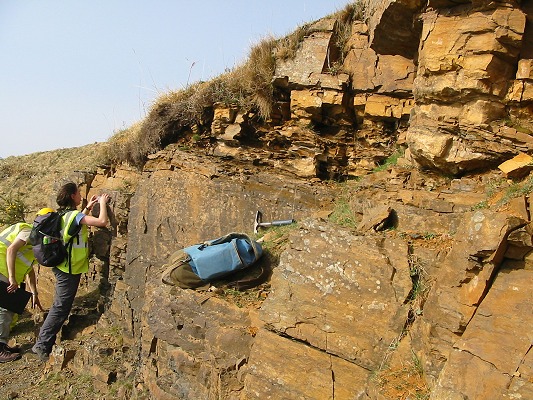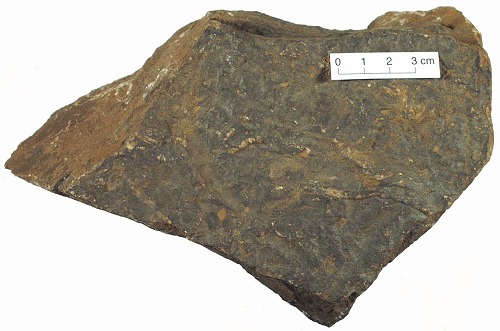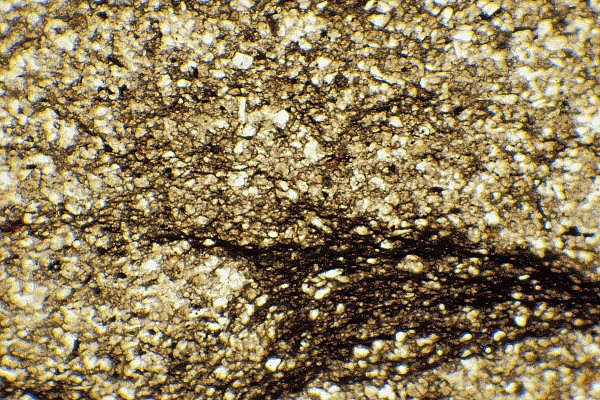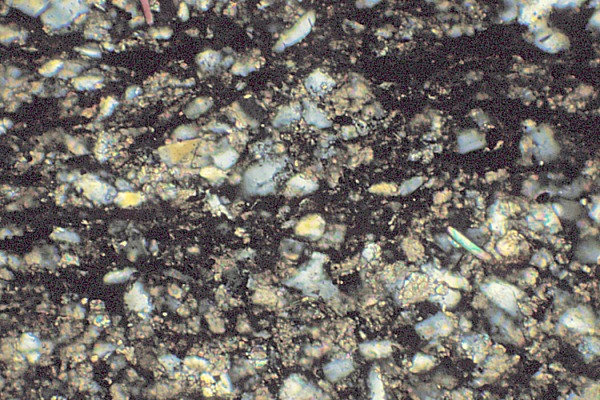
| Home | Geological History | Stratigraphy | Area map | Rock Index | About |
| Scourie | Achmelvich | Laxford | Clachtoll | Stoer | Assynt | Skiag Bridge | Glencoul | Knockan | Borralan | Ledmore |
Road-cut near Skiag Bridge, Loch Assynt

![]() Calcareous siltstone, Cambrian Fucoid beds, Loch Assynt
Calcareous siltstone, Cambrian Fucoid beds, Loch Assynt
The Fucoid beds are quite variable in appearance in
composition. Some are rich in carbonate, almost like
limestones, others are dark and flaky, more like shale.
This outcrop is quite rich in carbonate, but shows narrow
dark layers marking where the bedding planes are. The
orange-brown colour, fine grain size, and relative softness
distinguish this rock unit from the sandstones below and
above. The upper part of the outcrop shows the typical pits
and cavities caused by acid groundwater dissolving part of
the carbonate in the rock. The hammer shaft is 30 cm long.

![]() Calcareous siltstone, Cambrian Fucoid beds, Loch Assynt
Calcareous siltstone, Cambrian Fucoid beds, Loch Assynt
This view is of a bedding plane. It shows a dark-stained
uneven surface with ridges and furrows. The rock unit got
its name from the early belief that these markings were the
compressed remains of seaweeds (fucoids). Now it is thought
that they are the trails left by feeding creatures on the
sea floor. The rest of the specimen shows the orange-brown
colour characteristic of the rock unit.

![]() Calcareous siltstone, Cambrian Fucoid beds,
Loch Assynt
Calcareous siltstone, Cambrian Fucoid beds,
Loch Assynt
This thin section view shows the silt-sized grains of
sediment, much of which is dolomite (calcium magnesium
carbonate), and also branching irregular bands of dark
material.
Plane polarized light, field of view 3 mm across.

![]() Calcareous siltstone, Cambrian Fucoid beds,
Loch Assynt
Calcareous siltstone, Cambrian Fucoid beds,
Loch Assynt
This is an even more magnified view of the
carbonate-bearing siltstone. Grey and yellow grains are
quartz, dolomite grains are bright-speckled, and there are
one or two elongate flakes of mica.
Crossed polars, field of view 1 mm across.
| Scourie | Achmelvich | Laxford | Clachtoll | Stoer | Assynt | Skiag Bridge | Glencoul | Knockan | Borralan | Ledmore |
| Home | Geological History | Stratigraphy | Area map | Rock Index | About |
D.J. Waters, Department of Earth Sciences, May 2003